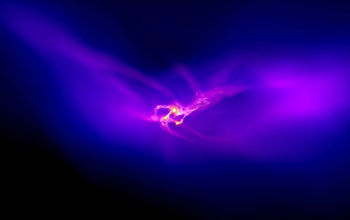Multimedia Gallery
30,000 light-year region from the 'Renaissance Simulation'
Between 2011 and 2014, a 70-terabyte dataset called the "Renaissance Simulation" was created on the Blue Waters supercomputer to help scientists understand how the universe evolved during its early years. This 30,000 light-year region from the Renaissance Simulation centers on a cluster of young galaxies that generate radiation (white) and metals (green), while heating the surrounding gas. A dark matter halo just outside this heated region forms three supermassive stars (inset), each over 1,000 times the mass of our sun, that will quickly collapse into massive black holes and eventually supermassive black holes over billions of years.
[This research was funded in part by the National Science Foundation (NSF) (grants PHY 1430152, AST 1514700, AST 1614333, OAC 1835213 and AST 1109243). The simulation was performed on Blue Waters, operated by the National Center for Supercomputing Applications (NCSA) with PRAC allocation support by NSF awards OAC 0832662, OAC 1238993 and OAC 1514580). The subsequent analysis and the re-simulations were performed with NSF’s XSEDE allocation on the Stampede2 resource. This research is part of the Blue Waters sustained-petascale computing project, which is supported by NSF (awards OAC 0725070 and OAC 1238993) and the state of Illinois. Blue Waters is a joint effort of the University of Illinois at Urbana-Champaign and its NCSA.]
To learn more about this research, see the Georgia Tech news story Birth of massive black holes in the early universe revealed. (Date image taken: unknown; date originally posted to NSF Multimedia Gallery: Aug. 19, 2019)
Credit: Advanced Visualization Lab, National Center for Supercomputing Applications
Images and other media in the National Science Foundation Multimedia Gallery are available for use in print and electronic material by NSF employees, members of the media, university staff, teachers and the general public. All media in the gallery are intended for personal, educational and nonprofit/non-commercial use only.
Images credited to the National Science Foundation, a federal agency, are in the public domain. The images were created by employees of the United States Government as part of their official duties or prepared by contractors as "works for hire" for NSF. You may freely use NSF-credited images and, at your discretion, credit NSF with a "Courtesy: National Science Foundation" notation.
Additional information about general usage can be found in Conditions.
Also Available:
Download the high-resolution JPG version of the image. (193.0 KB)
Use your mouse to right-click (Mac users may need to Ctrl-click) the link above and choose the option that will save the file or target to your computer.

 All images in this series
All images in this series